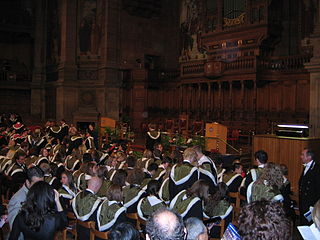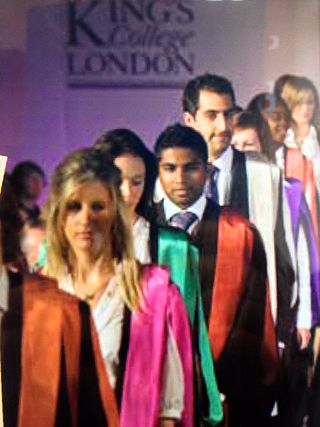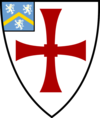
The University of Oxford has a long tradition of academic dress, which continues to the present day.
The academic dress of the former University of Wales was designed for the first graduations in 1893, and has as its main identifying feature a faculty colour scheme involving 'shot silks'.

The University of Cambridge has a long tradition of academic dress, which it traditionally refers to as academical dress. Almost every degree which is awarded by the University has its own distinct gown in addition to having its own hood. Undergraduates wear college gowns, which are all subtly different; these differences enable the wearer's college to be determined. Academic dress is worn quite often in Cambridge on formal, and sometimes informal, occasions, and there are a number of rules and customs governing when and how it is worn. Black gowns (undress) are worn at less formal events, while on special occasions full academical dress is worn, consisting of gown, hood and headdress with Doctors in festal dress. The University's officials also have ancient forms of academic dress, unique to the University.
The academic dress prescribed by the University of Bristol is a mixture of that prescribed by Cambridge and Oxford. Bristol has chosen, for graduates, to mainly specify Oxford-style gowns and Cambridge-style hoods. Unlike many British universities, the hood itself is to be "University red", lined with a specified colour. University red is defined to be Pantone 187. Bristol also specifies that undergraduates are to wear gowns "of the approved pattern" in certain circumstances, although the pattern itself is not specified. This is not too important since, in practice, undergraduates are only required to be gowned when graduating or at dinner as a member of Wills Hall.
Academic dress at the University of St Andrews involves students wearing distinctive academic gowns whilst studying at the University of St Andrews. Undergraduate gowns in Scotland were once common at all the ancient universities of Scotland, with each having its own distinctive style. St Andrews undergraduates wear either a scarlet gown if they are part of the United College and studying in the Faculties of Arts, Medicine and Science, or a black gown if they are part of St Mary's College and studying in the Faculty of Divinity.
The academic and official dress of the University of Warwick dates originally from the mid-1960s, shortly after the university's foundation. Despite persistent offers from Charles Franklyn the theatrical costume designer Anthony Powell was commissioned to design robes for officials and graduates of the university. Due to pressure of other work, and some apparent differences of opinion, Powell withdrew from the project, and the robes for graduates subsequently designed in consultation with J. Wippell and Company of Exeter, with Ede and Ravenscroft designing and making the robes for officials.

The academic dress of the University of Melbourne refers to the formal attire, including robes, gowns, and hoods, as prescribed by the Statutes and Regulations for undergraduates, graduates, officers, and honorands of the university. This follows the style of the University of Oxford for the gowns and hoods for Bachelors and Masters degrees. Melbourne adopts the style of the University of Cambridge for its doctorates. The hoods are all black, resembling the size and shape of the Oxford MA hoods, which are in the simple Burgon shape. These hoods are lined with the color specified for the corresponding faculty or degree and are bound with white on the lower edge for bachelors, while masters' hoods have no binding. The specific faculty or degree colors are outlined in the University Regulations. In the past, Pass degrees were bound in fur and Honours degrees in silk; however, this distinction no longer holds. Bachelors wear an Oxford Bachelors gown, while Masters wear an Oxford Masters gown. The gown for undergraduate students is the same as the bachelors', but its sleeves must not be split.
Academic dress of the University of London describes the robes, gowns and hoods which are prescribed by the university for its graduates and undergraduates.
There are a number of universities in Queensland, Australia, all with distinct academic dress.
This page describes the different types of academic dress allowed at the University of Exeter. Definitions of the academic dress for the award holders and officials of the university are set out in the university's regulations.
The University of Leeds, like other universities in the United Kingdom and many other countries throughout the world, has its own unique system of academic and ceremonial dress for undergraduates, graduates and senior officials. As at most other universities, graduands will wear the gown, hood and hat appropriate to the degree they are about to receive. All of the graduates' hoods incorporate one or more shades of green, and the Doctors of Philosophy, Education and Clinical Psychology are unique in the UK in having a green full-dress gown.

Academic dress at the University of Edinburgh is compulsory at official ceremonial occasions, such as graduation and the installations of Rector and Chancellor, and otherwise optional, usually only worn for events.

Academic dress prescribed at the Trinity College Dublin follows a relatively complex protocol which, nonetheless, shares some particular characteristics with other universities in Ireland and with its sister institutions at the University of Oxford and University of Cambridge in the United Kingdom.
The academic dress of the Royal Melbourne Institute of Technology (RMIT) are the robes, gowns and hoods prescribed by the Australian university for the administration, faculty, graduates, postgraduates and undergraduates of its Australian and Vietnamese branches. The academic dress of RMIT is described as similar to that of the University of Oxford in the United Kingdom. The current statute of academic dress was approved by the RMIT Council in 1980.

Academic dress of the University of Manchester describes the gowns, hoods and headwear which are prescribed by the university for its graduates and officers.

Graduates and associates of Imperial College London wear its academic dress. After gaining its independence from the University of London in 2007, graduates began wearing Imperial academic dress in 2008. The unifying colour for Imperial's academic dress is purple after the work by William Henry Perkin.

The academic dress of the United Kingdom and Ireland has a long history and has influenced the academic dress of America and beyond. The academic square cap was invented in the UK as well as the hood which developed from the lay dress of the medieval period.

The academic dress of McGill University describes the caps, gowns and hoods which are prescribed by the university for its degree candidates/holders. Until the mid-20th century, McGill also prescribed academic dress for its matriculating or enrolled students as well as its faculty. Founded in 1821, McGill University is consistently ranked as one of Canada's pre-eminent universities, and among the top 20 universities in the world.
The academic dress of the Robert Gordon University is normally only worn at graduation ceremonies and occasionally at other very formal events. In common with most British universities, a graduand of the Robert Gordon University begins the ceremony wearing the dress of the degree to which they are being admitted except for the hood. This is in contrast to the practice at some universities such as Oxford where a graduand only dons the dress of a degree after it has been conferred. The current pattern of academic dress dates from 1992 when the institution became a university.
The academic dress of the University of Tasmania describes the formal attire of robes, gowns and hoods prescribed by the ordinance of academic dress of the University of Tasmania. The ordinance prescribes the Oxford style for the gowns and hoods for both undergraduate and postgraduate academic dress.












